In iOS projects I do something like that:
tableView.rowHeight = UITableViewAutomaticDimension
tableView.estimatedRowHeight = 30
and have nicely resizing cells.
What should I do to reproduce the same behaviour in macOS project?
Ok, func tableView(_ tableView: NSTableView, heightOfRow row: Int) -> CGFloat.
Should I configure my SubView (cell view) (that actually is NSView) twice...
In both methods - heightOfRow and viewFor tableColumn?
I heard about reusing of cells, but can it be done without nibs?
Anyway, if I doing so I get not quite the intended result.
Delegate/Datasource:
let items = ["second label",
"second label with alotoftext alotof...", // long line
"second label"]
func numberOfRows(in tableView: NSTableView) -> Int {
return 3
}
func tableView(_ tableView: NSTableView, heightOfRow row: Int) -> CGFloat {
let cell = SubView(text: items[row])
cell.layoutSubtreeIfNeeded()
return cell.frame.size.height
}
func tableView(_ tableView: NSTableView, viewFor tableColumn: NSTableColumn?, row: Int) -> NSView? {
return SubView(text: items[row])
}
SubView:
init(text: String) {
super.init(frame: CGRect.zero)
let text1 = NSTextField(labelWithString: "first label")
let text2 = NSTextField(labelWithString: text)
text2.lineBreakMode = .byWordWrapping
text2.setContentCompressionResistancePriority(100, for: .horizontal)
self.addSubview(text1)
self.addSubview(text2)
text1 <- [Top(5), Left(5), Right(5)]
text2 <- [Top(0).to(text1, .bottom), Left(5), Right(5), Bottom(5)]
}
Last two lines are EasyPeasy constraints.
Where is my mistake?
And just one more question: what should I do to make cells grow/decrease vertically to fit all subviews inside of them accordingly to resizing width of tableView?
Oh, seem to have realized.
Just added the observer:
name: NSNotification.Name.NSViewFrameDidChange,
object: self.scrollView
And
let vr = scrollView.contentView.visibleRect
let indexes = tableView.rows(in: vr).toRange()!
tableView.noteHeightOfRows(withIndexesChanged: IndexSet(integersIn: indexes))
in selector method.
Yep. The same view (SubView) works perfect without tableView.


But I still have the above-described problem with wrong-sized cellViews.
P.S.: Sorry for my english, I hope everything is clear.
